Recognizing the Symptoms of Athlete's Foot
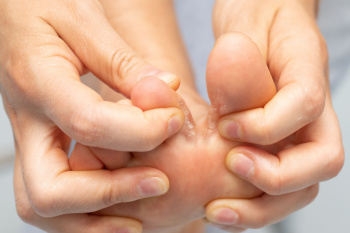
Athlete's foot is a common fungal infection that affects the skin on the feet, often causing discomfort and irritation. The most common symptoms include itching, burning, and redness between the toes or on the soles of the feet. In some cases, the skin may begin to crack, peel, or blister, which can lead to pain or tenderness. The infection may also cause a foul odor, especially if it is left untreated. In severe cases, athlete's foot can spread to the toenails or the rest of the body. The fungus thrives in warm, damp environments, so people who frequent public pools, gyms, or locker rooms are at higher risk. Proper hygiene, such as keeping the feet dry and using antifungal treatments, is essential for managing and preventing athlete's foot. Athlete’s foot can be uncomfortable and unsightly. If you have any of the above symptoms, it is suggested that you consult a podiatrist who can effectively treat this condition.
Athlete’s foot is an inconvenient condition that can be easily reduced with the proper treatment. If you have any concerns about your feet and ankles, contact Dr. Joshua David Scoll from Pennsylvania. Our doctor will treat your foot and ankle needs.
Athlete’s Foot: The Sole Story
Athlete's foot, also known as tinea pedis, can be an extremely contagious foot infection. It is commonly contracted in public changing areas and bathrooms, dormitory style living quarters, around locker rooms and public swimming pools, or anywhere your feet often come into contact with other people.
Solutions to Combat Athlete’s Foot
- Hydrate your feet by using lotion
- Exfoliate
- Buff off nails
- Use of anti-fungal products
- Examine your feet and visit your doctor if any suspicious blisters or cuts develop
Athlete’s foot can cause many irritating symptoms such as dry and flaking skin, itching, and redness. Some more severe symptoms can include bleeding and cracked skin, intense itching and burning, and even pain when walking. In the worst cases, Athlete’s foot can cause blistering as well. Speak to your podiatrist for a better understanding of the different causes of Athlete’s foot, as well as help in determining which treatment options are best for you.
If you have any questions please feel free to contact one of our offices located in Philadelphia, Bensalem, and Fairless Hills, PA . We offer the newest diagnostic and treatment technologies for all your foot and ankle needs.
Why Running Stores Are Not the Best for a Gait Analysis

Getting a gait analysis at a running store may not give the most accurate results for choosing the right running shoes. Many stores use simple arch tests, which do not fully capture the complexity of individual foot movement. Standing on a surface does not mimic how feet move while running, and even video analysis of running may miss important details. Foot motion is not just about arch shape or basic pronation. It can involve the inner arch dropping, the heel tilting, or the forefoot rotating. Often, these movements happen together, making foot mechanics more complex than store tests suggest. For a true understanding of how your feet move and the best shoe fit, it is suggested that seeing a podiatrist is a better choice. This type of doctor can evaluate your whole body’s movement to ensure you get shoes that match your unique needs.
If you are a runner, wearing the right running shoe is essential. For more information, contact Dr. Joshua David Scoll from Pennsylvania. Our doctor can provide the care you need to keep you pain-free and on your feet.
Choosing the Right Running Shoe for Your Foot Type
To increase performance and avoid the risk of injury, it is important to choose the right running shoe based on your foot type. The general design of running shoes revolves around pronation, which is how the ankle rolls from outside to inside when the foot strikes the ground.
- Neutral runners are able to choose from a wide variety of shoes, including minimalist shoes or even going barefoot.
- Runners who overpronate, or experience an over-abundance of ankle rolling, should choose shoes that provide extra motion control and stability.
- Runners who underpronate, or supinate, have feet that have high arches and lack flexibility, preventing shock absorption. They require shoes with more flexibility and cushion.
If you have any questions please feel free to contact one of our offices located in Philadelphia, Bensalem, and Fairless Hills, PA . We offer the newest diagnostic and treatment technologies for all your foot and ankle needs.
Dealing With Cracked Heels
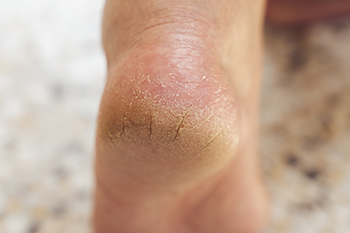
Cracked heels are a common foot condition characterized by dry, thickened skin that develops fissures around the edges of the heel. Common causes include prolonged standing, improper footwear, dry skin, and underlying health issues such as diabetes or eczema. Symptoms often include visible cracks, rough skin, discomfort, and sometimes bleeding or pain. If left untreated, cracked heels can lead to infections and more serious complications. Treatment involves moisturizing the feet regularly, using exfoliating scrubs to remove dead skin, and wearing supportive shoes to alleviate pressure. A podiatrist can provide specialized care, offering treatments such as professional debridement, customized orthotics, and tailored advice on foot care routines. If you are struggling with cracked heels, consulting a podiatrist is suggested. They can accurately assess your condition and develop a personalized treatment plan to restore your foot health.
If the skin on your feet starts to crack, you may want to see a podiatrist to find treatment. If you have any concerns, contact Dr. Joshua David Scoll from Pennsylvania. Our doctor can provide the care you need to keep you pain-free and on your feet.
Cracked Heels
It is important to moisturize your cracked heels in order to prevent pain, bleeding, and infection. The reason cracked heels form is because the skin on the foot is too dry to support the immense pressure placed on them. When the foot expands, the dry skin on the foot begins to split.
Ways to Help Heal Them
- Invest in a good foot cream
- Try Using Petroleum Jelly
- Ease up on Soaps
- Drink Plenty of Water
Ways to Prevent Cracked Heels
- Moisturize After Showering
- Skip a Shower
- Keep Shower Water Lukewarm
- Don’t Scrub Your Feet
If you are unsure how to proceed in treating cracked heels, seek guidance from a podiatrist. Your doctor will help you with any questions or information you may need.
If you have any questions, please feel free to contact one of our offices located in Philadelphia, Bensalem, and Fairless Hills, PA . We offer the newest diagnostic and treatment technologies for all your foot care needs.
Causes of Ingrown Toenails
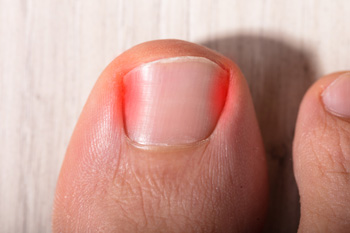
Ingrown toenails occur when the nail grows into the surrounding skin causing pain, swelling, and sometimes infection. Common causes include improper nail trimming by cutting nails too short or rounding the edges, leading the nail to grow into the skin. Wearing tight or narrow shoes can also push the nail into the skin, increasing the risk. Other common causes include trauma, such as stubbing or injuring the toe, and repetitive pressure from activities like running. Less common causes include genetic predisposition, where nail shape naturally curves into the skin, and nail disorders or fungal infections that alter nail growth. A podiatrist diagnoses ingrown toenails by examining the affected toe for signs of redness, swelling, and infection. Treatment varies by severity, with mild cases usually requiring trimming and proper nail care guidance. More severe cases may need partial nail removal, antibiotics for infection, and sometimes a minor surgical procedure to prevent recurrence. If you have an ingrown toenail, it is strongly suggested that you visit a podiatrist for proper treatment.
Ingrown toenails can become painful if they are not treated properly. For more information about ingrown toenails, contact Dr. Joshua David Scoll of Pennsylvania. Our doctor can provide the care you need to keep you pain-free and on your feet.
Ingrown Toenails
Ingrown toenails occur when a toenail grows sideways into the bed of the nail, causing pain, swelling, and possibly infection.
Causes
- Bacterial infections
- Improper nail cutting such as cutting it too short or not straight across
- Trauma to the toe, such as stubbing, which causes the nail to grow back irregularly
- Ill-fitting shoes that bunch the toes too close together
- Genetic predisposition
Prevention
Because ingrown toenails are not something found outside of shoe-wearing cultures, going barefoot as often as possible will decrease the likeliness of developing ingrown toenails. Wearing proper fitting shoes and using proper cutting techniques will also help decrease your risk of developing ingrown toenails.
Treatment
Ingrown toenails are a very treatable foot condition. In minor cases, soaking the affected area in salt or antibacterial soaps will not only help with the ingrown nail itself, but also help prevent any infections from occurring. In more severe cases, surgery is an option. In either case, speaking to your podiatrist about this condition will help you get a better understanding of specific treatment options that are right for you.
If you have any questions please feel free to contact one of our offices located in Philadelphia, Bensalem, and Fairless Hills, PA . We offer the newest diagnostic and treatment technologies for all your foot and ankle needs.
Understanding a Plantar Fibroma
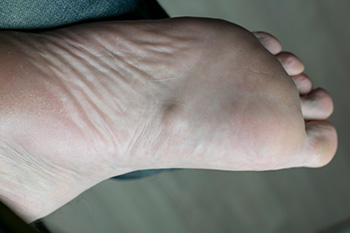
A plantar fibroma is a benign tumor that develops in the plantar fascia, the thick band of tissue running along the bottom of the foot. Typically found in the arch, it appears as a firm lump that may cause discomfort during walking or standing. Diagnosing a plantar fibroma involves a thorough medical history and physical examination, where a podiatrist will assess the lump's size, location, and texture. Imaging studies such as ultrasound or MRI scans may be employed to confirm the diagnosis and rule out other conditions. The exact causes of plantar fibromas remain unclear, though factors such as genetics, trauma, and certain medical conditions may contribute to their development. Having a plantar fibroma can be uncomfortable. If you have developed this condition, it is suggested that you consult a podiatrist who can offer you relief options.
A plantar fibroma may disrupt your daily activities. If you have any concerns, contact Dr. Joshua David Scoll of Pennsylvania. Our doctor can provide the care you need to keep you pain-free and on your feet.
Plantar Fibroma
A plantar fibroma is a fibrous knot in the arch of the foot. It is embedded in the plantar fascia which is a band of tissue that extends from the heel to the toes along the bottom of the foot. There can be multiple plantar fibromas in the feet at the same time. There are no known causes for this condition. If you have a plantar fibroma, there will be a bump in the arch of your foot that cannot be missed. Any associated pain is most often due to a shoe rubbing against the nodule. Non-surgical options, such as steroid injections, physical therapy, and orthotics should be tried first. Surgery is a last resort and is the only thing that will remove a plantar fibroma entirely. Consult with a podiatrist for a proper diagnosis and to determine the treatment regimen that is right for you.
What Causes a Plantar Fibroma?
While there are no specific causes identified, a plantar fibroma can possibly come from genetic predisposition or the formation of scar tissue that forms from healing the tears in the plantar fascia.
What Are the Symptoms of a Plantar Fibroma?
There will be a noticeable lump in the arch of the foot that may or may not cause pain. If pain is felt, it is typically because a shoe is rubbing up against the lump or when walking or standing barefoot.
Treatment and Prevention
A plantar fibroma will not disappear without treatment, but it can get smaller and be a non-issue. If pain persists, a podiatrist examines the foot and when the arch of the foot is pressed, pain can be felt down to the toes. An MRI or biopsy might be performed to help diagnose or evaluate the plantar fibroma. The following non-surgical options are generally enough to reduce the size and pain of these nodules:
- Steroid injections
- Orthotics
- Physical therapy to help apply anti-inflammatory creams on the bump
Surgery is considered if the mass increases in size and the patient continues to feel pain after non-surgical methods are tried.
If you have any questions please feel free to contact one of our offices located in Philadelphia, Bensalem, and Fairless Hills, PA . We offer the newest diagnostic tools and technology to treat your foot and ankle needs.
Why Does Pregnancy Cause Foot Pain?
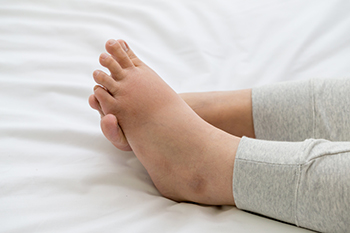
Pregnancy often brings a range of physical changes, and foot pain is a common complaint among expectant mothers. As the body prepares for childbirth, hormonal fluctuations cause ligaments to loosen, which can lead to instability in the feet and ankles. Additionally, the growing uterus increases weight and pressure on the feet, contributing to discomfort and swelling. The shift in the body's center of gravity during pregnancy can alter walking patterns, placing added stress on the feet. Edema, or swelling, commonly occurs due to fluid retention, causing feelings of heaviness and pain. Changes in foot shape, often resulting in wider and flatter feet, can also lead to discomfort. If you have developed foot pain while pregnant, it is suggested that you confer with a podiatrist who can help you to find relief during this transformative time.
Pregnant women with swollen feet can be treated with a variety of different methods that are readily available. For more information about other cures for swollen feet during pregnancy, consult with Dr. Joshua David Scoll from Pennsylvania. Our doctor will attend to all of your foot and ankle needs.
What Foot Problems Can Arise During Pregnancy?
One problem that can occur is overpronation, which occurs when the arch of the foot flattens and tends to roll inward. This can cause pain and discomfort in your heels while you’re walking or even just standing up, trying to support your baby.
Another problem is edema, or swelling in the extremities. This often affects the feet during pregnancy but tends to occur in the later stages.
How Can I Keep My Feet Healthy During Pregnancy?
- Wearing orthotics can provide extra support for the feet and help distribute weight evenly
- Minimize the amount of time spent walking barefoot
- Wear shoes with good arch support
- Wear shoes that allow for good circulation to the feet
- Elevate feet if you experience swelling
- Massage your feet
- Get regular, light exercise, such as walking, to promote blood circulation to the feet
If you have any questions please feel free to contact one of our offices located in Philadelphia, Bensalem, and Fairless Hills, PA . We offer the newest diagnostic and treatment technologies for all your foot and ankle needs.
Arthritic Foot Pain
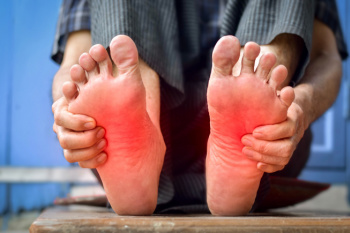
Foot pain can be a sign of arthritis, a condition that affects the joints and causes inflammation, stiffness, and discomfort. Several types of arthritis can affect the feet, including osteoarthritis, rheumatoid arthritis, and gout. Osteoarthritis is the most common type of arthritis, often linked to wear and tear in the joints over time. Rheumatoid arthritis is an autoimmune condition that affects multiple joints, usually starting in smaller joints like those in the feet. Gout typically targets the big toe with sudden, intense pain. Symptoms of arthritis in the feet include swelling, stiffness, reduced range of motion, and persistent pain that worsens with activity or at rest. Left untreated, arthritis can lead to joint damage and deformities causing other daily activities to become difficult. If you have persistent foot pain, it is suggested that you consult a podiatrist for an examination, diagnosis, and treatment.
Arthritis can be a difficult condition to live with. If you are seeking treatment, contact Dr. Joshua David Scoll from Pennsylvania. Our doctor can provide the care you need to keep you pain-free and on your feet.
Arthritic Foot Care
Arthritis is a term that is commonly used to describe joint pain. The condition itself can occur to anyone of any age, race, or gender, and there are over 100 types of it. Nevertheless, arthritis is more commonly found in women compared to men, and it is also more prevalent in those who are overweight. The causes of arthritis vary depending on which type of arthritis you have. Osteoarthritis for example, is often caused by injury, while rheumatoid arthritis is caused by a misdirected immune system.
Symptoms
- Swelling
- Pain
- Stiffness
- Decreased Range of Motion
Arthritic symptoms range in severity, and they may come and go. Some symptoms stay the same for several years but could potentially get worse with time. Severe cases of arthritis can prevent its sufferers from performing daily activities and make walking difficult.
Risk Factors
- Occupation – Occupations requiring repetitive knee movements have been linked to osteoarthritis
- Obesity – Excess weight can contribute to osteoarthritis development
- Infection – Microbial agents can infect the joints and trigger arthritis
- Joint Injuries – Damage to joints may lead to osteoarthritis
- Age – Risk increases with age
- Gender –Most types are more common in women
- Genetics – Arthritis can be hereditary
If you suspect your arthritis is affecting your feet, it is crucial that you see a podiatrist immediately. Your doctor will be able to address your specific case and help you decide which treatment method is best for you.
If you have any questions, please feel free to contact one of our offices located in Philadelphia, Bensalem, and Fairless Hills, PA . We offer the newest diagnostic and treatment technologies for all your foot care needs.
Black Toe and Critical Limb Ischemia
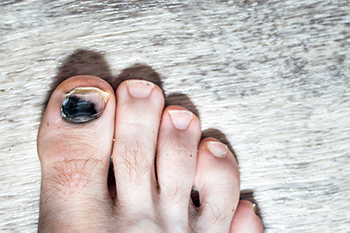
Critical limb ischemia, or CLI, is a serious condition caused by poor blood flow, often due to diabetes or hardened arteries. It leads to severe pain, wounds that will not heal, and even dead tissue. If left untreated, one might need to have their toe amputated, and many others may not survive within a year. CLI can also be linked to black toe, as both conditions result from poor circulation. In severe cases like CLI, lack of blood flow can cause the tissues, including toes, to die, leading to blackening. Treatment aims to restore blood flow to the toe through surgery or other procedures. If that is not possible, treatments like oxygen therapy or special compression can help relieve symptoms. Without any treatment, the affected area, including the black toe, may dry up and worsen. If you have a painful black or discolored toe, it is strongly suggested that you promptly schedule an appointment with a podiatrist for appropriate treatment.
Toe pain can disrupt your daily activities. If you have any concerns, contact Dr. Joshua David Scoll of Pennsylvania. Our doctor can provide the care you need to keep you pain-free and on your feet.
What Causes Toe Pain?
Most severe toe pain is caused due to a sports injury, trauma from dropping something heavy on the toe, or bumping into something rigid. Other problems can develop over time for various reasons.
Toe pain can be caused by one or more ailments. The most common include:
- Trauma
- Sports injury
- Wearing shoes that are too tight
- Arthritis
- Gout
- Corns and calluses
- Hammertoe
- Bunions
- Blisters
- Ingrown toenails
- Sprains
- Fractures (broken bones)
- Dislocations
When to See a Podiatrist
- Severe pain
- Persistent pain that lasts more than a week
- Signs of infection
- Continued swelling
- Pain that prevents walking
Diagnosis
In many cases the cause of toe pain is obvious, but in others, a podiatrist may want to use more advanced methods to determine the problem. These can range from simple visual inspections and sensation tests to X-rays and MRI scans. Prior medical history, family medical history, and any recent physical traumatic events will all be taken into consideration for a proper diagnosis.
Treatment
Treatments for toe pain and injuries vary and may include shoe inserts, padding, taping, medicines, injections, and in some cases, surgery. If you believe that you have broken a toe, please see a podiatrist as soon as possible.
If you have any questions please feel free to contact one of our offices located in Philadelphia, Bensalem, and Fairless Hills, PA . We offer the newest diagnostic tools and technology to treat your foot and ankle needs.
Consulting a Podiatrist for Ankle Pain

Ankle pain can result from various causes, ranging from acute injuries to chronic conditions. Common causes include sprains, where ligaments are stretched or torn due to sudden twisting motions, and tendonitis, which occurs when tendons surrounding the ankle become inflamed from overuse. Arthritis, particularly osteoarthritis, can lead to ankle pain over time due to joint wear and tear. Stress fractures or broken bones may also cause severe ankle pain following trauma. In some cases, flat feet or improper foot mechanics can put strain on the ankle, leading to discomfort. If pain persists or worsens, it is suggested that you visit a podiatrist for a proper diagnosis and treatment.
Ankle pain can be caused by a number of problems and may be potentially serious. If you have ankle pain, consult with Dr. Joshua David Scoll from Pennsylvania. Our doctor will assess your condition and provide you with quality foot and ankle treatment.
Ankle pain is any condition that causes pain in the ankle. Due to the fact that the ankle consists of tendons, muscles, bones, and ligaments, ankle pain can come from a number of different conditions.
Causes
The most common causes of ankle pain include:
- Types of arthritis (rheumatoid, osteoarthritis, and gout)
- Ankle sprains
- Broken ankles
- Achilles tendonitis
- Achilles tendon rupture
- Stress fractures
- Bursitis
- Tarsal tunnel syndrome
- Plantar fasciitis
Symptoms
Symptoms of ankle injury vary based upon the condition. Pain may include general pain and discomfort, swelling, aching, redness, bruising, burning or stabbing sensations, and/or loss of sensation.
Diagnosis
Due to the wide variety of potential causes of ankle pain, podiatrists will utilize a number of different methods to properly diagnose ankle pain. This can include asking for personal and family medical histories and of any recent injuries. Further diagnosis may include sensation tests, a physical examination, and potentially x-rays or other imaging tests.
Treatment
Just as the range of causes varies widely, so do treatments. Some more common treatments are rest, ice packs, keeping pressure off the foot, orthotics and braces, medication for inflammation and pain, and surgery.
If you have any questions, please feel free to contact one of our offices located in Philadelphia, Bensalem, and Fairless Hills, PA . We offer the newest diagnostic and treatment technologies for all your foot care needs.
Risk Factors for Ankle Sprains and Strains
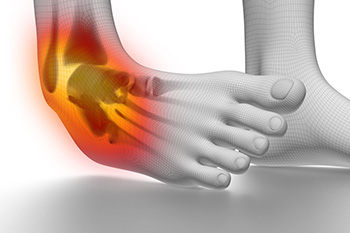
The ankles are remarkable joints that enable a wide range of movement, but they are also vulnerable to injuries such as sprains and strains. An ankle sprain, which is quite common, occurs when a ligament is overstretched or torn, while a strain involves overstretching or tearing of a muscle or tendon. Factors that can heighten the risk of these injuries include inadequate athletic conditioning, skipping warm-ups before exercise, pushing through muscle fatigue, carrying excess weight, and wearing unsupportive or poorly fitting shoes. These conditions can lead to significant pain and impact your mobility. To properly diagnose and treat ankle injuries, it is important to consult a professional. A podiatrist can provide expert evaluation, treatment options, and preventive advice to help you recover and reduce the risk of future injuries. If you are experiencing ankle pain, it is suggested you schedule an appointment with a podiatrist for personalized care and effective treatment.
Ankle sprains are common but need immediate attention. If you need your feet checked, contact Dr. Joshua David Scoll from Pennsylvania. Our doctor can provide the care you need to keep you pain-free and on your feet.
How Does an Ankle Sprain Occur?
Ankle sprains take place when the ligaments in your ankle are torn or stretched beyond their limits. There are multiple ways that the ankle can become injured, including twisting or rolling over onto your ankle, putting undue stress on it, or causing trauma to the ankle itself.
What Are the Symptoms?
- Mild to moderate bruising
- Limited mobility
- Swelling
- Discoloration of the skin (depending on severity)
Preventing a Sprain
- Wearing appropriate shoes for the occasion
- Stretching before exercises and sports
- Knowing your limits
Treatment of a Sprain
Treatment of a sprain depends on the severity. Many times, people are told to rest and remain off their feet completely, while others are given an air cast. If the sprain is very severe, surgery may be required.
If you have suffered an ankle sprain previously, you may want to consider additional support such as a brace and regular exercises to strengthen the ankle.
If you have any questions please feel free to contact one of our offices located in Philadelphia, Bensalem, and Fairless Hills, PA . We offer the newest diagnostic and treatment technologies for all your foot and ankle needs.
Facts About Morton’s Neuroma
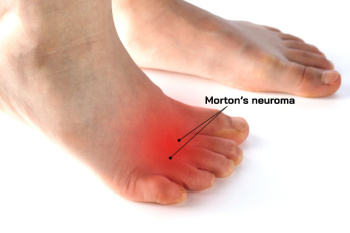
Morton’s neuroma is a painful condition affecting the nerves in the ball of the foot, typically between the third and fourth toes. This condition occurs when the tissue around the nerve thickens due to irritation or pressure, often from wearing tight or high-heeled shoes. Symptoms of Morton's neuroma include sharp pain, burning, or a sensation like stepping on a small stone. Numbness or tingling in the toes can also be experienced. Risk factors include wearing narrow footwear, having foot conditions like flat feet or bunions, or engaging in high-impact sports. A podiatrist can provide custom orthotics, lifestyle modifications, or non-invasive therapies to alleviate discomfort and prevent long-term damage. If left untreated, Morton’s neuroma can lead to chronic pain and permanent nerve damage, like numbness in the toes. If you have pain in the ball of the foot that may be from Morton’s neuroma, it is suggested that you make an appointment with a podiatrist for an exam, diagnosis, and treatment options.
Morton’s neuroma is a very uncomfortable condition to live with. If you think you have Morton’s neuroma, contact Dr. Joshua David Scoll of Pennsylvania. Our doctor will attend to all of your foot care needs and answer any of your related questions.
Morton’s Neuroma
Morton's neuroma is a painful foot condition that commonly affects the areas between the second and third or third and fourth toe, although other areas of the foot are also susceptible. Morton’s neuroma is caused by an inflamed nerve in the foot that is being squeezed and aggravated by surrounding bones.
What Increases the Chances of Having Morton’s Neuroma?
- Ill-fitting high heels or shoes that add pressure to the toe or foot
- Jogging, running or any sport that involves constant impact to the foot
- Flat feet, bunions, and any other foot deformities
Morton’s neuroma is a very treatable condition. Orthotics and shoe inserts can often be used to alleviate the pain on the forefront of the feet. In more severe cases, corticosteroids can also be prescribed. In order to figure out the best treatment for your neuroma, it’s recommended to seek the care of a podiatrist who can diagnose your condition and provide different treatment options.
If you have any questions, please feel free to contact one of our offices located in Philadelphia, Bensalem, and Fairless Hills, PA . We offer the newest diagnostic and treatment technologies for all your foot care needs.
A Guide to Types of Running Shoes

Selecting the appropriate running shoe is vital for both comfort and performance. There are several types to consider. Neutral running shoes offer balanced support and cushioning for those with a neutral gait. Stability shoes provide additional support for runners who overpronate or roll their feet inward excessively. Motion control shoes are designed for severe overpronation, offering maximum support and control. Trail running shoes feature rugged soles and enhanced traction for off-road conditions. When choosing the right shoe, consider factors like your foot type, running style, and the terrain you will be covering. It is also beneficial to try on different styles, as properly fitting shoes can prevent injuries and enhance your running experience. If you have endured a foot or ankle injury while running, it is suggested that you consult a podiatrist who can offer treatment options, in addition to guiding you on the right type of shoes to wear.
You should always make sure your running shoes fit properly in order to avoid injury. For more information, contact Dr. Joshua David Scoll from Pennsylvania. Our doctor can provide the care you need to keep you pain-free and on your feet.
Choosing the Right Running Shoe for Your Foot Type
Improper shoe sizing can cause a myriad of problems for your feet. Shoes that don’t fit you properly can lead to muscular imbalances in your body, which can result in foot, knee, and hip injuries.
Tips for Finding the Right Running Shoe
- Make sure you have a thumb’s width of wiggle room between the end of your longest toe and the front of the shoe.
- There should be little to no slipping at the heel
- Don’t assume your size in one shoe brand will be your size in another
- Do not lace up your shoes too tightly
- Walk around in the store with your new shoes before you buy them
If you have any questions please feel free to contact our one of our offices located in Philadelphia, Bensalem, and Fairless Hills, PA . We offer the newest diagnostic and treatment technologies for all your foot and ankle needs.
More...
Understanding Diabetic Foot Ulcers

Diabetic foot ulcers are sores or wounds that can develop on the feet of people with diabetes, often due to poor circulation, nerve damage, and prolonged pressure. These ulcers commonly occur on the soles of the feet and can become severe if not treated promptly. Symptoms include pain, swelling, and sometimes a foul odor if the ulcer becomes infected. Treatment for diabetic foot ulcers focuses on wound care and managing diabetes effectively. This involves cleaning the wound regularly, using specialized dressings, and offloading pressure with customized footwear or orthotic devices. In some cases, antibiotics may be needed to treat or prevent infection. For a comprehensive evaluation and tailored treatment plan, it’s suggested you make an appointment with a podiatrist. Their expertise can significantly improve outcomes and prevent serious complications from foot ulcers.
Diabetic foot care is important in preventing foot ailments such as ulcers. If you are suffering from diabetes or have any other concerns about your feet, contact Dr. Joshua David Scoll from Pennsylvania. Our doctor can provide the care you need to keep you pain-free and on your feet.
Diabetic Foot Care
Diabetes affects millions of people every year. The condition can damage blood vessels in many parts of the body, especially the feet. Because of this, taking care of your feet is essential if you have diabetes, and having a podiatrist help monitor your foot health is highly recommended.
The Importance of Caring for Your Feet
- Routinely inspect your feet for bruises or sores.
- Wear socks that fit your feet comfortably.
- Wear comfortable shoes that provide adequate support.
Patients with diabetes should have their doctor monitor their blood levels, as blood sugar levels play such a huge role in diabetic care. Monitoring these levels on a regular basis is highly advised.
It is always best to inform your healthcare professional of any concerns you may have regarding your feet, especially for diabetic patients. Early treatment and routine foot examinations are keys to maintaining proper health, especially because severe complications can arise if proper treatment is not applied.
If you have any questions please feel free to contact one of our offices located in Philadelphia, Bensalem, and Fairless Hills, PA . We offer the newest diagnostic and treatment technologies for all your foot and ankle needs.
Gout and Dietary Considerations
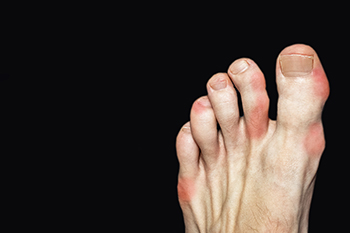
Gout is a form of arthritis caused by the accumulation of uric acid crystals in the joints, leading to sudden and severe pain, swelling, and redness. This condition typically affects the big toe but can impact other joints as well. Over time, frequent gout attacks can damage joints and affect overall quality of life. Certain foods can worsen gout symptoms, particularly those high in purines, which increase uric acid levels. If you have gout it is advisable to avoid consuming red meats, organ meats, and seafood such as shrimp and anchovies. Additionally, alcohol, especially beer, and sugary beverages can also contribute to higher uric acid levels. Gout can cause extreme pain and discomfort. If you have had one or more gout attacks, it is strongly suggested that you are under the care of a podiatrist who can help you manage this condition.
Gout is a foot condition that requires certain treatment and care. If you are seeking treatment, contact Dr. Joshua David Scoll from Pennsylvania. Our doctor will treat your foot and ankle needs.
What Is Gout?
Gout is a type of arthritis caused by a buildup of uric acid in the bloodstream. It often develops in the foot, especially the big toe area, although it can manifest in other parts of the body as well. Gout can make walking and standing very painful and is especially common in diabetics and the obese.
People typically get gout because of a poor diet. Genetic predisposition is also a factor. The children of parents who have had gout frequently have a chance of developing it themselves.
Gout can easily be identified by redness and inflammation of the big toe and the surrounding areas of the foot. Other symptoms include extreme fatigue, joint pain, and running high fevers. Sometimes corticosteroid drugs can be prescribed to treat gout, but the best way to combat this disease is to get more exercise and eat a better diet.
If you have any questions please feel free to contact one of our offices located in Philadelphia, Bensalem, and Fairless Hills, PA . We offer the newest diagnostic and treatment technologies for all your foot and ankle needs.
Toenail Fungus Treatments

Toenail fungus, or onychomycosis, is a condition where a fungal infection leads to discoloration, thickening, and crumbling of the nail. The primary causes are fungi that thrive in warm, moist environments, such as public showers, swimming pools, and sweaty shoes. People with a weakened immune system or those who have diabetes are at higher risk. Symptoms can include toenails becoming yellow or white, thickening, and sometimes separating from the nail bed. To prevent toenail fungus, maintain good foot hygiene, keep nails clean and dry, and avoid walking barefoot in communal areas. Treatment options vary, depending on the severity of the infection. Antifungal creams and nail lacquers may be effective for mild cases. Laser treatments and nail removal are options for severe cases. For persistent toenail infections, it is suggested you schedule an appointment with a podiatrist for appropriate treatment solutions, which may include prescribed medication.
For more information about treatment, contact Dr. Joshua David Scoll of Pennsylvania. Our doctor can provide the care you need to keep you pain-free and on your feet.
Toenail Fungus Treatment
Toenail fungus is a condition that affects many people and can be especially hard to get rid of. Fortunately, there are several methods to go about treating and avoiding it.
Antifungals & Deterrence
Oral antifungal medicine has been shown to be effective in many cases. It is important to consult with a podiatrist to determine the proper regiment for you, or potentially explore other options.
Applying foot powder on the feet and shoes helps keep the feet free of moisture and sweat.
Sandals or open toed shoes – Wearing these will allow air movement and help keep feet dry. They also expose your feet to light, which fungus cannot tolerate. Socks with moisture wicking material also help as well.
If you have any questions please feel free to contact one of our offices located in Philadelphia, Bensalem, and Fairless Hills, PA . We offer the newest diagnostic tools and technology to treat your foot and ankle needs.
Toenail Problems

Toenail problems can cause significant discomfort and require attention. Ingrown toenails occur when the nail grows into the surrounding skin, leading to pain and infection. Nail fungus causes thickened, discolored nails and can spread if untreated. Toenail trauma from injuries can result in bruising, separation from the nail bed, or deformities. Clubbed nails, often associated with underlying health conditions, involve the enlargement and rounding of the nail tips. Discoloration of nail plates may indicate fungal infections, trauma, or systemic issues. If you have painful or unusual problems with your toenails, it is suggested that you schedule an appointment with a podiatrist for a diagnosis, specialized treatment, and to prevent possible complications.
Ingrown toenails may initially present themselves as a minor discomfort, but they may progress into an infection in the skin without proper treatment. For more information about ingrown toenails, contact Dr. Joshua David Scoll of Pennsylvania. Our doctor can provide the care you need to keep you pain-free and on your feet.
Ingrown Toenails
Ingrown toenails are caused when the corner or side of a toenail grows into the soft flesh surrounding it. They often result in redness, swelling, pain, and in some cases, infection. This condition typically affects the big toe and may recur if it is not treated properly.
Causes
- Improper toenail trimming
- Genetics
- Improper shoe fitting
- Injury from pedicures or nail picking
- Abnormal gait
- Poor hygiene
You are more likely to develop an ingrown toenail if you are obese, have diabetes, arthritis, or have any fungal infection in your nails. Additionally, people who have foot or toe deformities are at a higher risk of developing an ingrown toenail.
Symptoms
Some symptoms of ingrown toenails are redness, swelling, and pain. In rare cases, there may be a yellowish drainage coming from the nail.
Treatment
Ignoring an ingrown toenail can have serious complications. Infections of the nail border can progress to a deeper soft-tissue infection, which can then turn into a bone infection. You should always speak with your podiatrist if you suspect you have an ingrown toenail, especially if you have diabetes or poor circulation.
If you have any questions, please feel free to contact one of our offices located in Philadelphia, Bensalem, and Fairless Hills, PA . We offer the newest diagnostic and treatment technologies for all your foot care needs.




